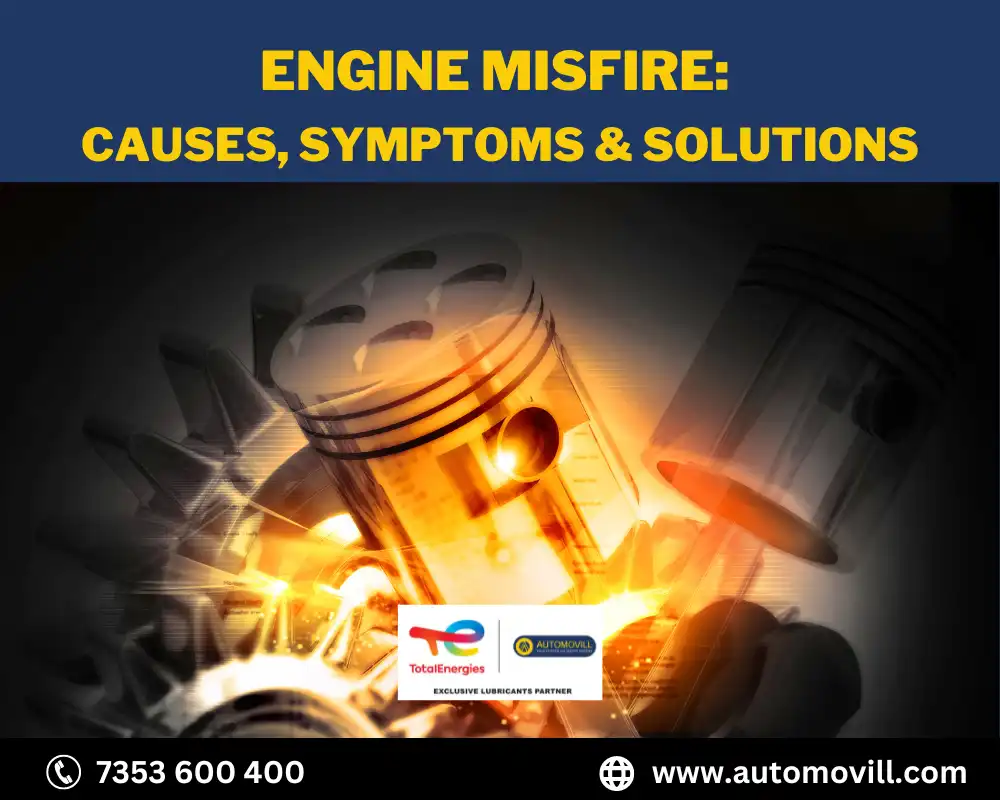
The engine is the heart of any vehicle which consists of many components like the fuel system, ignition parts, electrical system, AC, etc. and when any part malfunctions, it can lead to various problems that not only affect the performance but also could be frustrating and potentially dangerous situations. One common problem that car owners encounter is an engine misfire.
In this blog post, we will explore the causes, symptoms, and solutions related to engine misfires.
What is an Engine Misfire?
An engine misfire refers to a condition where the combustion process in one or more cylinders of an internal combustion engine fails to occur properly. It can result in a variety of issues, including reduced power, rough idling, increased fuel consumption, and even engine damage if left unresolved.
Causes of Engine Misfires
- Ignition System Issues:
- Faulty spark plugs: Worn-out or damaged spark plugs can cause a weak or insufficient spark, leading to misfires.
- Ignition coil failure: A malfunctioning ignition coil can result in inconsistent sparks or complete failure to deliver spark to the spark plugs.
- Ignition module failure: The ignition module controls the timing and distribution of sparks. When it fails, misfires may occur.
- Fuel System Problems:
- Clogged fuel injectors: Deposits or debris in the fuel injectors can disrupt the fuel spray pattern, affecting the combustion process.
- Fuel pump failure: A weak or failing fuel pump may not deliver adequate fuel pressure, resulting in a lean or rich fuel mixture, leading to misfires.
- Fuel filter clog: A clogged fuel filter restricts the flow of fuel, potentially causing misfires.
- Air Intake Issues:
- Vacuum leaks: Unmetered air entering the engine due to vacuum leaks can disrupt the air-fuel ratio, leading to misfires.
- Mass airflow sensor (MAF) failure: A malfunctioning MAF sensor can provide incorrect data to the engine control unit (ECU), causing misfires.
- Throttle body issues: A dirty or faulty throttle body can affect the airflow, leading to misfires.
- Mechanical Problems:
- Low compression: Issues like worn piston rings, damaged valves, or a blown head gasket can result in reduced compression, leading to misfires.
- Timing belt or chain failure: If the timing belt or chain breaks or slips, the engine’s valve timing may be affected, causing misfires.
- Engine overheating: Excessive heat can warp components and damage the engine, leading to misfires.
Symptoms of Engine Misfires
- Check Engine Light (CEL): A flashing or illuminated CEL is often the first indication of an engine misfire. The vehicle’s onboard diagnostic system detects the misfire and triggers the warning light.
- Rough Idling: When one or more cylinders misfire, the engine may idle roughly or experience fluctuations in RPM. The vehicle may shake or vibrate noticeably.
- Loss of Power and Acceleration: Misfires can cause a significant loss of power, making it difficult to accelerate or maintain speed.
- Increased Fuel Consumption: Engine misfires can lead to incomplete combustion, resulting in unburned fuel. This can cause increased fuel consumption and reduced fuel efficiency.
- Abnormal Exhaust Emissions: Misfires can generate abnormal exhaust emissions, including white smoke (coolant leak), black smoke (rich fuel mixture), or blue smoke (burning oil).
Solutions for Engine Misfires
- Diagnose the Problem:
- Use an OBD-II scanner: Retrieve error codes stored in the vehicle’s computer system to identify the specific cylinders experiencing misfires.
- Conduct a visual inspection: Check for damaged or worn-out ignition components, such as spark plugs, ignition coils, and wires.
- Address Ignition System Issues:
- Replace faulty spark plugs: Install new spark plugs according to the manufacturer’s specifications.
- Replace defective ignition coils: Faulty ignition coils should be replaced with high-quality replacements.
- Repair or replace faulty ignition module: Consult a professional mechanic to address issues related to the ignition module.
- Resolve Fuel System Problems:
- Clean or replace clogged fuel injectors: Professional fuel injector cleaning or replacement may be required.
- Replace a failing fuel pump: A malfunctioning fuel pump should be replaced to ensure proper fuel delivery.
- Replace a clogged fuel filter: If the fuel filter is clogged, replace it to maintain adequate fuel flow.
- Address Air Intake Issues:
- Inspect and repair vacuum leaks: Identify and repair any vacuum leaks using proper diagnostic techniques.
- Clean or replace a faulty MAF sensor: Cleaning or replacing the MAF sensor can restore accurate air intake readings.
- Clean or replace a dirty throttle body: Cleaning the throttle body or replacing a faulty one can improve airflow.
- Resolve Mechanical Problems:
- Conduct a compression test: Measure the compression in each cylinder to identify any mechanical issues.
- Inspect and replace the timing belt or chain: If the timing belt or chain is damaged, it should be replaced promptly.
- Address engine overheating: Determine the cause of overheating and repair or replace damaged components.
Conclusion
Engine misfires can be frustrating and detrimental to the performance of your vehicle. By addressing the causes and symptoms, and implementing the appropriate solutions, you can effectively address engine misfires and restore your engine’s optimal performance.
Remember, for complex issues, it’s always best to consult not just a skilled but experienced mechanic to diagnose and resolve engine misfire problems to avoid heavy damage.
